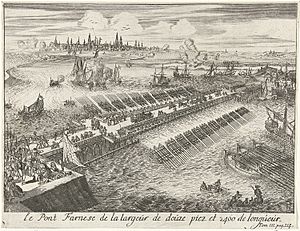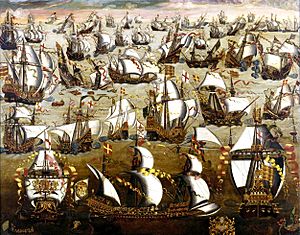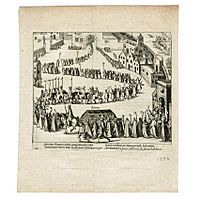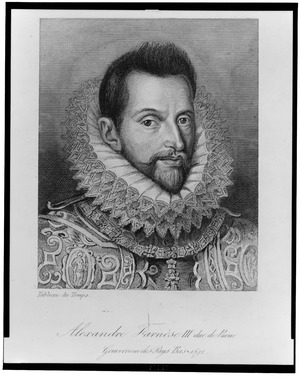Alexander Farnese, Duke of Parma facts for kids
Quick facts for kids Alessandro Farnese |
|
|---|---|

Portrait of Farnese by Otto van Veen
|
|
| Duke of Parma and Piacenza | |
| Reign | 15 September 1586 – 3 December 1592 |
| Predecessor | Ottavio |
| Successor | Ranuccio I |
| Governor of the Spanish Netherlands | |
| Reign | 1 October 1578 – 3 December 1592 |
| Predecessor | John of Austria |
| Successor | Peter Ernst I von Mansfeld-Vorderort |
| Born | 27 August 1545 Rome, Papal States |
| Died | 3 December 1592 (aged 47) Arras, Kingdom of France |
| Burial | Santa Maria della Steccata |
| Spouse | Infanta Maria of Portugal |
| Issue | Ranuccio I Farnese, Duke of Parma Margherita, Hereditary Princess of Mantua Cardinal Oddoardo |
| House | Farnese |
| Father | Ottavio Farnese |
| Mother | Margaret of Parma |
| Religion | Roman Catholicism |
| Signature |  |
Alexander Farnese (born August 27, 1545 – died December 3, 1592) was an Italian noble and a skilled general. He led the Spanish army and was known as the Duke of Parma and Piacenza from 1586 to 1592. He also served as the Governor of the Spanish Netherlands from 1578 to 1592.
Alexander Farnese was a brilliant military leader. He helped Spain regain control of many towns in what is now Belgium. He also played a key role in the French Wars of Religion, helping the Catholics. Many people at the time, and even historians today, consider him one of the best military commanders of his era.
Contents
Early Life and Family: 1545-1577
Alexander was born on August 27, 1545. His father was Duke Ottavio Farnese of Parma. His mother was Margaret of Austria, who was the daughter of Emperor Charles V, the King of Spain. Alexander had a twin brother, Carlo, who sadly died when he was young.
In 1556, Alexander moved to Brussels with his mother, who became the Governor of the Netherlands. He was then sent to Spain to live with his cousin, Don Carlos, and his uncle, Don Juan. They were all around the same age.
In 1565, Alexander married Maria of Portugal. This marriage ended his time as a "hostage" of King Philip II. Their wedding in Brussels was a grand event. Alexander later commanded three ships in the Battle of Lepanto (1571) against the Turks.
After this, he didn't have a chance to show his military skills for seven years. During this time, the provinces of the Netherlands began to rebel against Spanish rule. Don Juan was sent to restore order, but he struggled against William the Silent, who had united the provinces.
Leading the Spanish in the Netherlands
In late 1577, Alexander Farnese brought Spanish troops from Italy to help Don Juan. His smart plans and quick decisions helped win the Battle of Gembloux (1578) in early 1578. After this, the town of Zichem was captured and looted, which was a dark moment in Farnese's career.
In October 1578, Don Juan died, and King Philip II chose Farnese to take his place. Farnese became the main commander of the Spanish army and later the Governor-General of the Netherlands.
Alexander faced a difficult situation because his opponents were divided. He cleverly used these divisions to his advantage. He convinced the Catholic southern provinces to rejoin the king's side through the Union of Arras in January 1579. In response, the seven northern provinces formed the Union of Utrecht, declaring their independence from Spain.
Reclaiming Towns by Force
Farnese began to recapture towns in Brabant and Flanders. He started with the Siege of Maastricht in March 1579. His soldiers dug tunnels under the city walls. The people of Maastricht also dug tunnels to fight back. Many soldiers died in these underground battles.
On June 29, Farnese's men finally entered the city. Since the city had not surrendered, the Spanish soldiers looted it for three days. Many civilians were killed. This looting was very violent, partly because Farnese was sick with a fever at the time.
Later, Farnese offered good terms for towns to surrender. He promised no massacres or looting, and that old city rights would be kept. He also offered pardons and a gradual return to the Catholic Church.
A major achievement for Alexander Farnese was the siege of Antwerp. This was a large port city, well-fortified, and bravely defended. The siege began in 1584. Farnese showed his military genius by building a bridge of boats across the Scheldt River. This cut off Antwerp from the sea, despite the efforts of the city's defenders.
The terms of surrender for Antwerp included that all Protestants had to leave the city within four years. Farnese's capture of Antwerp was orderly, unlike the violent "Spanish Fury" that happened there earlier. With Antwerp, Mechelen, and Brussels under his control, most of the southern Netherlands was back under Spanish rule.
Alexander continued his campaigns to secure trade routes along the Meuse and Rhine rivers. However, King Philip II's lack of money began to affect Farnese's army. In December 1585, Farnese's troops faced severe food shortages. They marched towards the Rhine and Meuse regions to find supplies. During this difficult winter, the "Miracle of Empel" saved his army. By June 1586, the Siege of Grave (1586) was successful.
In 1586, Alexander became Duke of Parma after his father died. He never actually ruled Parma, instead naming his son Ranuccio as regent. He wanted to visit his home, but Philip II would not let him leave the Netherlands.
The Spanish Armada
Philip II wanted to invade England, which was supporting the Dutch rebels. Alexander Farnese was not very excited about this plan. He believed an invasion was possible with 30,000 troops if certain conditions were met. These included keeping the plan secret and preventing France from interfering.
However, Philip II decided on a different plan, which became known as the Spanish Armada. Farnese's troops were supposed to cross the English Channel in barges, protected by the Armada. The Armada entered the Channel in the summer of 1588.
Poor communication between Farnese and the Armada's commander, the Duke of Medina Sidonia, caused problems. Farnese's barges were not warships, and English ships were blocking him in port. He expected the Armada to clear a path. But Medina Sidonia expected Farnese to fight his way out. The English attack on the Armada at the Battle of Gravelines made it impossible for them to meet.
After the Armada failed, Alexander Farnese faced more challenges. He abandoned the siege of Bergen Op Zoom in September 1588 as winter approached. His last major victory in the Netherlands was capturing Geertruidenberg in 1589.
French Wars of Religion
Alexander Farnese began to suffer from swelling in his body after the failed siege of Bergen op Zoom. He had to go to the town of Spa for treatment for about six months. During this time, some of his troops rebelled due to lack of pay.
First Trip to France
Farnese wanted to focus on the northern Netherlands, but in August 1589, the French King Henry III was killed. Philip II ordered Farnese to go to France to support the Catholic side against the Protestant Henri de Navarre. Farnese warned Philip that this would hurt their progress in the Netherlands.
Farnese arrived in France in August 1590. His main goal was to help Paris, which was under a long siege by Henry IV's forces. Farnese did not want a direct battle with Henry's army. Instead, he captured a fort at Lagny-sur-Marne. This opened up the Marne River for supplies to reach Paris.
Two days later, Henry IV stopped the siege of Paris. Farnese then secured another supply route by capturing Corbeil-Essonnes. With Paris supplied, Farnese returned to the Netherlands in December 1590. His journey back was difficult, with bad weather and Henry IV's forces harassing him.
Maurice of Nassau's Actions
While Farnese was in France, Maurice of Nassau led the Dutch rebels in attacks. The Spanish forces, without Farnese, struggled with lack of money and supplies. This period allowed the Dutch to improve their military tactics. Alexander Farnese had finally met a strong opponent in Maurice.
Second Trip to France
In July 1591, Philip II again ordered Alexander Farnese to go to France to help the Catholic League. Farnese was relieved to leave a difficult siege he was fighting in the Netherlands. He went back to Spa for more treatment.
In January 1592, Farnese met with the Catholic League leaders in France. He prepared to help rescue Rouen, which was under siege by Henry IV. Farnese first captured Neufchâtel-en-Bray to keep his supply lines open.
On April 20, Farnese arrived near Rouen, and Henry IV lifted the siege. Rouen was saved. However, Farnese was wounded in the arm by a musket shot while scouting the town of Caudebec-en-Caux. His health worsened, and he had to call his son Ranuccio to take command.
Henry IV tried to cut off the Catholic army's supplies. Farnese, despite being very ill, came up with a clever plan to secretly cross the Seine River with his army. The Catholic army escaped right under Henry IV's nose. After returning to the Netherlands, Farnese received a letter from Pope Clement VIII congratulating him for saving the Catholic army. He then went back to Spa for more treatments.
Death
Alexander Farnese's Recall
After the failed Armada campaign, some people in Philip II's court were jealous of Farnese. They tried to turn the king against him. Philip II, who had always favored Alexander, began to listen to these complaints. The king decided to remove Farnese from his post in the Netherlands.
Philip II sent letters to recall Farnese, but Alexander did not know about these plans. He continued to prepare for another campaign to help the Catholic League in France.
Final Journey and Death
Even though he was very ill, Alexander Farnese prepared for this new campaign. He made sure his family's lands would have a ruler after his death by sending his son back to Parma.
The Duke left Brussels on November 11 and arrived in Arras. There, on December 2, 1592, he died at the age of 47.
His body was moved to Parma and buried next to his wife. Later, their remains were moved to the Basilica of the Madonna della Steccata, where they are today. His death meant he never saw the official order removing him from his position. In 2020, his remains were examined, and it was determined he died of pneumonia.
Issue
Alexander Farnese had three children with his wife, Infanta Maria of Portugal:
| Name | Birth | Death | Notes |
|---|---|---|---|
| Margherita Farnese | 7 November 1567 | 13 April 1643 | Married Vincenzo I, Duke of Mantua in 1581. They had no children. |
| Ranuccio Farnese | 28 March 1569 | 5 March 1622 | Became Duke of Parma after his father. He married Margherita Aldobrandini in 1600 and had children. |
| Odoardo Farnese | 7 December 1573 | 21 February 1626 | Became a Cardinal in the Catholic Church. |
Gallery
-
Farnese marries Maria Princess of Portugal by Jan Luyken (1720)
See also
 In Spanish: Alejandro Farnesio (duque de Parma) para niños
In Spanish: Alejandro Farnesio (duque de Parma) para niños














